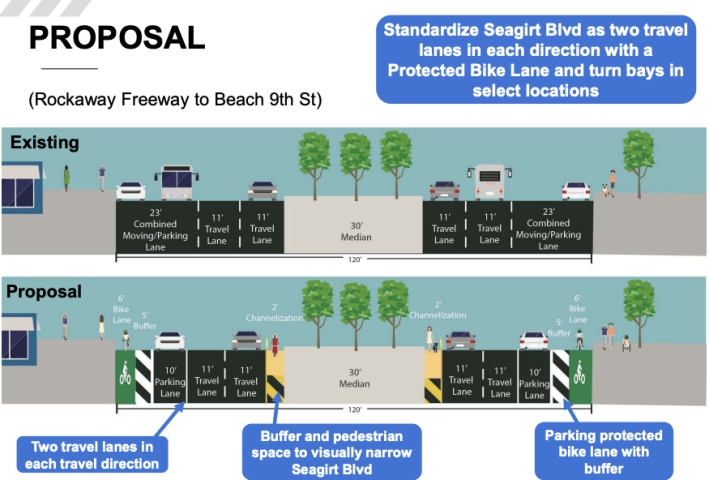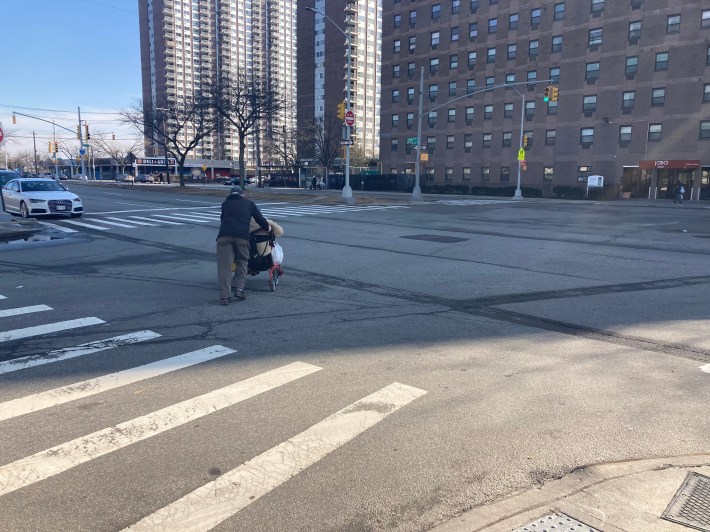A dangerous roadway in Far Rockaway that for years had been passed over for any substantive safety design changes is finally slated for improvements this month, the city announced last week.
Over the next few weeks, the Department of Transportation will redesign a roughly one-mile stretch of Seagirt Boulevard from Rockaway Freeway to Beach Ninth Street by repurposing the current six-lane speedway into two lanes of traffic with extra pedestrian space, and a parking-protected bike lane.
“The project will improve safety for all users, providing connections to existing bike infrastructure and the reduction of a vehicle lane encouraging safer speeds,” said Tomas Garita, a spokesperson for DOT.

Seagirt Boulevard, as Streetsblog reported back in February, is an example of systemic racism in infrastructure. The roadway has for years been a known hot spot for crashes, where drivers, thanks to the highway-like design of the corridor, speed with impunity. In 2019, a camera at the intersection of Seagirt Boulevard and Crest Road issued the most speed camera tickets in the city, according to the Department of Transportation last year, it handed out 18,289 tickets, or roughly 50 per day.
But besides installing speed cameras along the stretch in November 2018, the corridor has remained unchanged since at least 2007 — and there’s been dozens of crashes to show for it. The intersection of Seagirt Boulevard and Beach 20th Street, where a speed camera last year issued 11,982 tickets, was designated a Vision Zero Priority Intersection after 10 severe pedestrian injuries and two fatalities between 2014 and 2018, according to DOT.
Since 2019, there have been 222 crashes on the one-mile stretch, leading to 87 injuries — including to 63 motorists, 18 pedestrians, and six cyclists — and one motorist fatality, according to Crash Mapper.
Speed cameras can’t make a street safer on their own, advocates say.
“The best way to prevent speeding is with road design that forces drivers to slow down. This is exactly what the city should do when a speed safety camera continually catches a high number of speeders," said Laura Shepard, Queens Organizer for Transportation Alternatives. "DOT's move to turn car space into protected bike lanes on Seagirt Boulevard, while shortening crossings and expanding median space, will prevent speeding and make it safer to walk, bike, and take transit."
But without any safety upgrades, members of the community, which has a large population of older New Yorkers, have been rightly scared to cross the boulevard. Between 2015 and 2019, 23 percent of pedestrian crashes involved a victim who was a senior, according to DOT.
“There’s a lot of crazy drivers out here,” a bus rider named Sharieal who was waiting near Beach 26th Street, and who declined to give her last name, told Streetsblog earlier this year.

A majority 84 percent of residents said they supported the city’s plans to redesign the street for safety, according to DOT, which only first proposed the upgrades in 2021.
On either side of the 30-foot median that runs down the center of Seagirt Boulevard, the city plans to create a two-foot buffer for pedestrians to help “visually narrow” the corridor, along with two 11-foot travel lanes in each director and a six-foot wide parking protected bike lane with a five-foot buffer on either side, according to DOT’s plans. In addition, the city will install daylighting treatments at intersections and driveways to help visibility as well as improved markings.
Queens Borough President Donovan Richards said the changes have been a long time coming and will hopefully keep residents of the neighborhood, the majority of whom are people of color, safe from reckless drivers.
“Far too many people are killed and injured on our city’s streets, especially people of color, who are disproportionately impacted by traffic violence, “ said Richards. “We need to be aggressive in redesigning our streets and implementing other measures that will help keep everyone who uses our roadways safe. The improvements planned for Seagirt Boulevard are a great step forward in that direction.”






